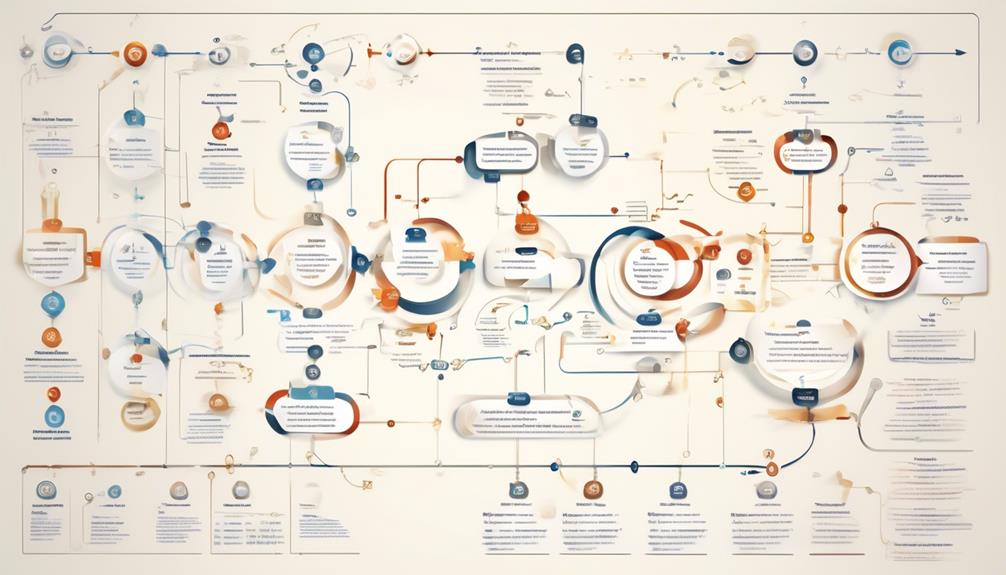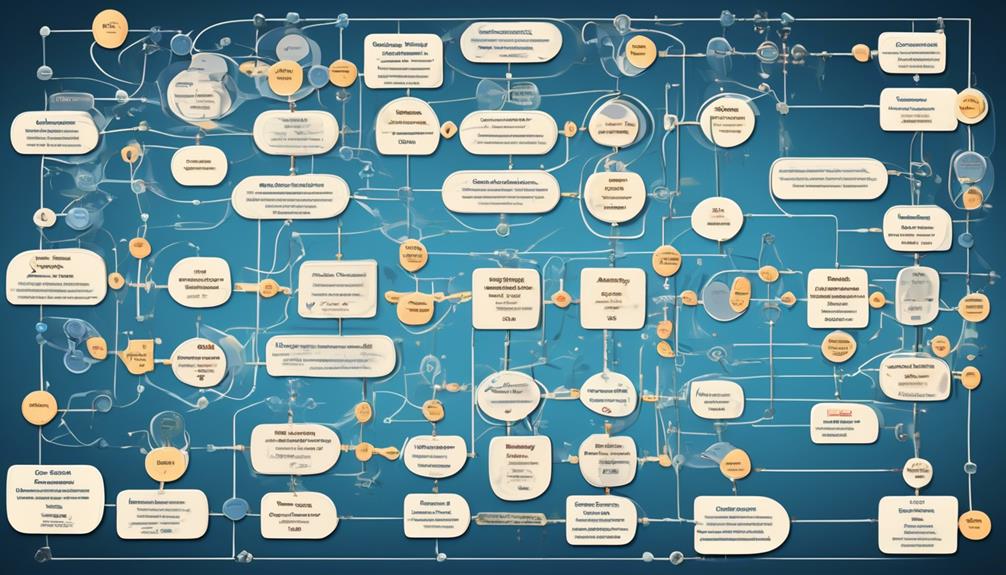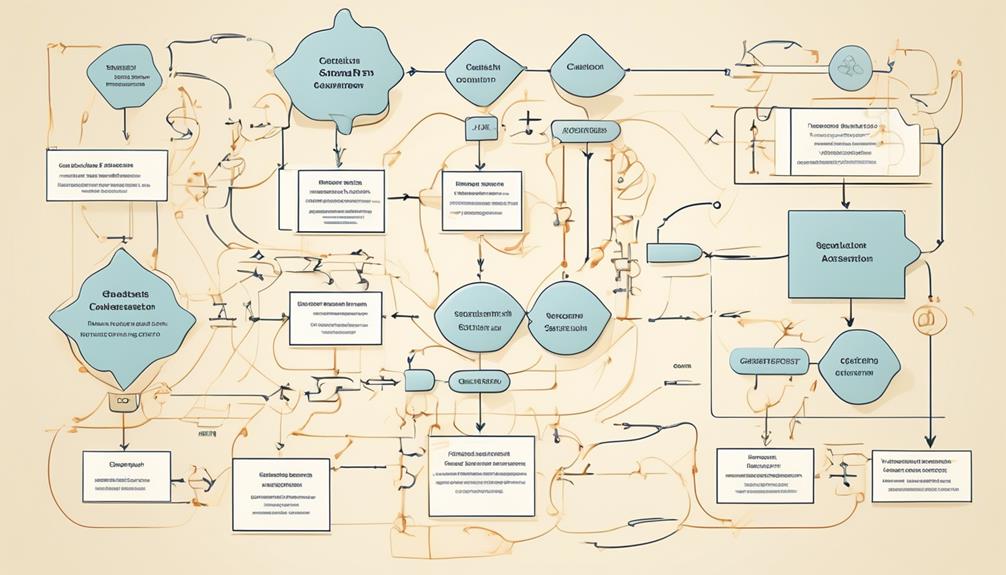Quality Assurance
Quality Assurance Overview: Ensuring Excellence Quality Control

Welcome to our detailed guide on quality assurance and its vital role in upholding high standards in quality control. Being at the forefront of the industry, we recognize the importance of providing our clients with superior products and services. Hence, we emphasize greatly on quality assurance and are committed to offering you essential knowledge and the finest strategies to maintain top quality levels.
Quality assurance is the process of systematically monitoring and evaluating the various aspects of a product or service to ensure it meets predefined quality standards. It involves a combination of planning, implementation, and continuous improvement to ensure consistent excellence.
In this guide, we will explore the fundamentals of quality assurance, its impact on customer satisfaction, and its vital role in upholding quality standards. We will also delve into the various methods, processes, and systems that organizations can implement to ensure product or service quality. Additionally, we will discuss the difference between quality assurance and quality control, and how both contribute to quality improvement.
Our aim is to equip you with the knowledge and tools necessary to implement effective quality assurance practices and create a robust quality management system. By prioritizing quality assurance, you can enhance customer satisfaction, build trust, and establish a reputation for excellence in your industry.
Key Takeaways:
- Quality assurance plays a crucial role in maintaining excellence in quality control
- It involves monitoring and evaluating products or services to ensure predefined quality standards are met
- Implementing effective quality assurance practices can enhance customer satisfaction
- Quality assurance forms the foundation for a robust quality management system
- By prioritizing quality assurance, organizations can establish a reputation for excellence
What is Quality Assurance and Its Importance?
In today’s fast-paced and competitive business environment, ensuring the excellence of products and services is paramount for organizations looking to gain a competitive edge. This is where quality assurance comes into play. Quality assurance refers to the systematic process of ensuring that products, processes, and services consistently meet or exceed predetermined quality standards.
Quality assurance is not to be confused with quality control. While quality control focuses on identifying and fixing defects in the final product or service, quality assurance is a proactive approach that aims to prevent issues from arising in the first place. It is a preventive measure that emphasizes the importance of implementing robust quality management systems.
So, why is quality assurance so important in product or service development? The answer lies in its ability to enhance customer satisfaction, increase efficiency, and drive continuous improvement. By adhering to strict quality assurance processes, organizations can ensure that their products or services consistently meet customer requirements and expectations.
In software development, quality assurance plays a critical role in ensuring the reliability, functionality, and security of the software. It involves rigorous testing, code reviews, and adherence to coding standards, ensuring that the final product is of high quality and free from bugs or vulnerabilities.
A robust quality management system is the backbone of effective quality assurance. It encompasses a set of interconnected processes, procedures, and policies aimed at achieving and maintaining consistent quality throughout the organization. A well-implemented quality management system not only ensures compliance with quality standards but also fosters a culture of continuous improvement and customer-centricity.
By prioritizing quality assurance and implementing a comprehensive quality management system, organizations can enhance their reputation, build customer trust, and gain a competitive advantage in the market.
Quality Assurance Methods and Processes
In order to ensure the highest level of product or service quality, organizations employ various quality assurance methods and processes. These strategies are designed to identify and rectify any potential issues or defects, guaranteeing that the final deliverable meets the required standards and customer expectations. Let’s explore some of the most effective quality assurance testing strategies and processes that organizations can implement:
Effective Quality Assurance Testing Strategies
Quality assurance testing is a crucial component of the overall quality management process. By conducting thorough and systematic testing, organizations can identify and address any defects or inconsistencies before the product or service is released to the market. Some effective quality assurance testing strategies include:
- Functional Testing: This type of testing validates that the product or service functions as intended and meets the specified requirements.
- Performance Testing: Performance testing assesses the product or service’s ability to perform under different conditions and loads, ensuring it meets performance expectations.
- Security Testing: Security testing identifies any vulnerabilities or weaknesses in the product or service’s security measures, protecting sensitive data from potential threats.
- User Acceptance Testing: User acceptance testing involves testing the product or service with end-users to ensure it meets their needs and expectations.
- Regression Testing: Regression testing verifies that recent changes or updates to the product or service have not introduced any new defects or issues.
Implementing Statistical Process Control in Quality Assurance
Statistical process control (SPC) is a valuable technique used in quality assurance to monitor and control production processes. By using statistical methods and tools, organizations can ensure that their processes are stable, predictable, and capable of consistently producing high-quality outputs. SPC involves:
- Collecting and analyzing data to identify trends and patterns in process performance.
- Using statistical techniques, such as control charts and process capability analysis, to monitor and control process variability.
- Determining the appropriate control limits to indicate when a process is in or out of control.
- Implementing corrective actions when process performance deviates from the desired standards.

Quality Assurance Programs and Systems
Organizations can establish quality assurance programs and systems to ensure consistent and effective quality management. These programs and systems provide a framework for controlling quality across various functions and processes. They typically include:
- Standard operating procedures (SOPs) and work instructions that outline quality-related processes and tasks.
- Document control systems to manage and maintain up-to-date versions of quality-related documents.
- Training and education programs to equip employees with the necessary knowledge and skills to adhere to quality standards.
- Internal audit processes to assess adherence to quality requirements and identify areas for improvement.
- Corrective and preventive action (CAPA) processes to address non-conformances and prevent their recurrence.
Quality Assurance in the Context of Total Quality Management
Quality assurance plays a vital role in the broader context of total quality management (TQM). TQM is a comprehensive approach to quality management that involves the active participation of all employees and focuses on continuous improvement. Quality assurance ensures that the principles and practices of TQM are implemented effectively, enabling organizations to achieve and exceed customer expectations. By integrating quality assurance into the TQM framework, organizations can:
- Identify and eliminate root causes of quality issues.
- Implement systematic and data-driven improvement initiatives.
- Establish clear quality objectives and performance metrics.
- Promote a culture of quality and continuous improvement throughout the organization.
ISO 9000 and Its Significance in Quality Assurance
ISO 9000 is an internationally recognized standard for quality management systems. Adhering to ISO 9000 standards demonstrates an organization’s commitment to delivering consistent, high-quality products or services. ISO 9000 provides a framework for implementing effective quality assurance practices and emphasizes the importance of:
- Establishing a customer-focused approach to quality management.
- Implementing robust processes and systems to control quality.
- Continually monitoring and improving quality performance.
- Engaging and empowering employees to contribute to quality objectives.
By aligning their quality assurance practices with ISO 9000, organizations can enhance customer satisfaction, improve operational efficiency, and drive continuous improvement in quality management.
Complete Table
| Quality Assurance Method/Process | Description |
|---|---|
| Effective Quality Assurance Testing Strategies | Thorough and systematic testing approaches to identify and address defects or inconsistencies. |
| Implementing Statistical Process Control | Using statistical methods/tools to monitor and control production processes. |
| Quality Assurance Programs and Systems | Establishing frameworks for controlling quality across functions and processes. |
| Quality Assurance in the Context of Total Quality Management | Integration of quality assurance into the broader TQM framework for continuous improvement. |
| ISO 9000 and Its Significance | Adherence to internationally recognized standards for quality management systems. |
Quality Assurance vs Quality Control: Understanding the Difference
In the world of quality management, two terms often come up: quality assurance and quality control. While they may sound similar, they have distinct roles and objectives. Let’s delve into these concepts and gain a clear understanding of their differences.
Defining the Differences Between Quality Assurance and Quality Control
Quality assurance (QA) is a proactive process focused on preventing defects and errors from occurring in the first place. It involves creating and implementing systems, procedures, and standards to ensure that the desired level of quality is consistently achieved. QA activities include quality planning, process reviews, and continuous improvement efforts to enhance overall quality performance.
On the other hand, quality control (QC) is a reactive process focused on identifying and correcting deviations from established quality standards. It involves inspecting, testing, and evaluating products or services to detect defects and ensure that they meet the predetermined quality criteria. QC activities include product inspections, sample testing, and statistical analysis to maintain quality compliance.
Quality Improvement Through Effective Quality Assurance and Quality Control
Both quality assurance and quality control play crucial roles in improving the overall quality of products or services. By implementing robust quality assurance practices, organizations can identify potential areas of improvement, establish effective processes, and minimize the occurrence of defects. Quality control, on the other hand, ensures that the established quality standards are upheld by conducting thorough inspections and tests, allowing for prompt identification and rectification of any deviations.
Ensuring Product or Service Quality through Quality Assurance and Quality Control
Quality assurance and quality control go hand in hand to ensure the delivery of high-quality products or services to customers. While quality assurance focuses on prevention and process improvement, quality control ensures that the final output meets the specified quality requirements. By implementing comprehensive quality management systems that encompass both QA and QC practices, organizations can provide consistent, reliable, and satisfying products or services to their customers.
The Role of Quality Audits in Quality Assurance and Quality Control
One of the essential components of quality assurance and quality control is conducting regular quality audits. Quality audits are systematic examinations of processes, procedures, and systems to assess their compliance with established quality standards. By periodically reviewing and evaluating various aspects of the organization’s quality management system, quality audits help identify areas for improvement, ensure adherence to quality guidelines, and mitigate the risk of non-compliance.
Implementing Quality Planning to Ensure Excellence in Quality Assurance and Quality Control
Quality planning is an integral part of both quality assurance and quality control. It involves the systematic identification of quality objectives, the development of quality plans, and the establishment of processes to achieve desired quality outcomes. By defining clear quality goals, outlining quality-related activities, and allocating appropriate resources, organizations can effectively execute quality assurance and quality control practices, leading to improved product or service quality, customer satisfaction, and overall organizational success.

| Quality Assurance | Quality Control |
|---|---|
| Proactive process | Reactive process |
| Focuses on prevention | Focuses on detection and correction |
| Ensures consistent quality | Verifies compliance to quality standards |
| Includes process reviews and improvement | Includes product inspections and testing |
| Minimizes defects and errors | Identifies and rectifies deviations |
The Role of Quality Management in Quality Assurance
In order to ensure the quality of our products or services, quality management plays a crucial role. Quality management encompasses a set of processes and practices that are focused on maintaining and improving the quality of our offerings. By implementing effective quality management systems, we are able to uphold high standards and meet the expectations of our customers.

Quality Management Systems and Their Impact on Quality Assurance
Quality management systems form the foundation of an organization’s quality assurance efforts. These systems consist of various interrelated processes and procedures that are designed to systematically monitor, control, and improve the quality of products or services throughout their lifecycle. By implementing a robust quality management system, we can ensure consistency, reliability, and continual improvement in our offerings.
Understanding the Concept of Quality and Its Importance in Quality Management
Quality is more than just meeting predetermined standards or specifications. It encompasses the entire customer experience and reflects the extent to which our products or services satisfy customer needs and expectations. Quality management recognizes the significance of meeting or exceeding customer requirements and seeks to continuously improve the processes and systems that contribute to product or service quality.
Effectively Meeting Quality Requirements through Quality Management
One of the primary objectives of quality management is to ensure that our products or services meet the specified quality requirements. This involves setting clear quality objectives, defining quality criteria, and implementing quality control measures to ensure the desired level of quality is achieved. By closely monitoring and measuring key quality indicators, we can identify areas for improvement and take proactive steps to enhance product or service quality.
The Aspects of Quality Management: Ensuring Excellence in Every Aspect
Quality management encompasses various aspects that are integral to delivering excellence in product or service quality. These aspects include:
- Leadership commitment and involvement in quality initiatives
- Employee engagement and empowerment to contribute to quality improvement
- Effective communication and collaboration to align quality objectives
- Data-driven decision-making based on accurate and reliable information
- Continuous learning and knowledge sharing to foster a culture of quality improvement
Ensuring Product or Service Quality through Quality Assurance
In today’s competitive market, organizations must prioritize the quality of their products or services to stay ahead. This is where quality assurance plays a crucial role. By implementing robust quality assurance processes in product development, companies can ensure that their offerings meet the highest standards.
Quality assurance also extends beyond product development and encompasses service quality management. Organizations can effectively implement quality assurance measures to maintain consistent service quality, enhancing customer satisfaction. Through thorough testing, monitoring, and evaluation, potential quality issues can be identified and resolved, ensuring that customers receive exceptional service.
Dealing with quality issues is another area where effective quality assurance initiatives come into play. By conducting regular audits and inspections, organizations can proactively identify and address any quality issues that may arise. This enables them to rectify the problems swiftly and prevent their recurrence, ultimately safeguarding product or service quality.
Ultimately, the goal of quality assurance is to ensure excellence in product or service quality. By implementing comprehensive quality assurance measures, organizations can establish a strong foundation for consistently delivering exceptional offerings to their customers. This dedication to quality leads to higher customer satisfaction, forging long-lasting relationships and fostering brand loyalty.
Quality Assurance FAQ
Q: What is the role of a quality assurance specialist in the software development process?
A: A quality assurance specialist plays a crucial role in the software development process. They not only control the quality of the product, but also ensure that all stages of the development meet the defined standards. Quality assurance helps in achieving higher quality of products and services.
Q: What is the difference between quality control and quality assurance?
A: Quality assurance and quality control are both parts of quality management focused on product quality. However, they serve different functions. Quality control focuses on detecting and correcting defects in the finished product, while quality assurance focuses on the process used to create the product. In other words, QA is a proactive process, while QC is a reactive one.
Q: How does software quality assurance ensure quality in the development process?
A: Software quality assurance is a part of quality management focused on providing confidence that quality requirements will be fulfilled. The QA process involves systematic activities and tasks to ensure quality in the development process, including regular reviews, audits and testing, hence it helps to maintain the quality of the product.
Q: What are the best practices for quality assurance in software development?
A: The best practices for quality assurance in software development include establishing a quality assurance system with clear strategies and procedures, conducting regular reviews and audits, continuous testing, close engagement with the development team, and focusing on continuous improvement.
Q: What’s the importance of quality in software development?
A: The importance of quality in software development cannot be overstated – it has a significant impact on user satisfaction, product performance, and the overall success of the product. Quality software meets the needs of the user, is reliable, and is free from defects. A strong quality assurance system can ensure these standards are met.
Q: What are the types of quality assurance in software development?
A: There are several types of quality assurance in software development, including process, product, and project quality assurance. Each focuses on different aspects of quality management: the methods used to create the product, the product itself, and the entire development cycle respectively.
### ###
Q: What is the role of quality assurance engineers in ensuring excellent quality control?
A: Quality assurance engineers are integral to ensuring excellent quality control. They design and execute tests, report issues to the development team, help troubleshoot issues, and ensure that all aspects of the software meet the quality standards set. Their work is a vital part of the quality assurance function, contributing significantly to the overall quality of the product.
Q: What is the QA process in software development?
A: The QA process in software development involves several steps, including planning and control, software development lifecycle testing, software development lifecycle observation, and conducting a final review. These steps ensure that the quality management is focused on meeting the quality requirements of the product.
Q: How does quality assurance system monitor and manage the quality of a product?
A: A quality assurance system monitors and manages product quality by implementing standard procedures and processes throughout the development lifecycle. It ensures all processes are carried out in accordance with set guidelines, enables early detection and prevention of potential errors or issues, and promotes a culture of continuous improvement in quality standards.
Q: Why is quality assurance often considered a critical part of software development?
A: Quality assurance is often considered a critical part of software development because it directly impacts the overall quality of the product. Through systematic activities and thorough testing, QA ensures that the software meets the defined quality standards and the expectations of the end user, leading to better customer satisfaction and trust in the product.
Rick, our Software Quality Assurance Writer, is the creative force behind many of our insightful articles and course materials. His unique background in software development, fused with his natural flair for writing, allows him to convey complex QA concepts in a way that is both informative and captivating. Rick is committed to keeping abreast of the latest trends and advancements in software testing, ensuring that our content remains not just relevant, but at the forefront of the field. His significant contributions are instrumental in helping us fulfill our mission to deliver premier QA education.

Quality Control Solutions
Navigating the ISO Certification Quality Control Journey
Laying the groundwork for ISO certification compliance is crucial for organizational success, but the real challenge lies in the journey ahead.

As we embark on the journey to achieve ISO Certification for Quality Control, we face the challenge of setting clear objectives and defining the scope of our Quality Management System (QMS).
The road ahead requires a strategic approach to ensure compliance with ISO 9001 standards, from establishing quality policies and documenting procedures to effectively implementing and communicating the QMS to all employees.
However, the real test lies in the successful completion of internal and external audits, which will determine our organization's ability to obtain and sustain the coveted ISO 9001 certification.
Key Takeaways
- ISO Certification is a globally recognized standard that demonstrates an organization's commitment to quality, efficiency, and continuous improvement.
- Understanding ISO 9001 and 27001 standards is crucial for identifying quality control requirements.
- Establishing clear, measurable quality control objectives aligned with ISO certification requirements and industry regulations is essential.
- Documenting quality control processes, conducting regular internal audits, and preparing for the certification audit are necessary steps in achieving ISO certification.
Understanding ISO Certification
Understanding ISO Certification involves comprehending the globally recognized standard that demonstrates an organization's commitment to quality, efficiency, and continuous improvement. ISO, which stands for the International Organization for Standardization, sets forth rigorous criteria for organizations to follow in order to achieve certification. This process involves a thorough evaluation of the organization's quality management system to ensure that it meets the stringent requirements of the ISO standards. Quality lies at the core of ISO certification, emphasizing the importance of consistently delivering products and services that meet customer and regulatory requirements.
The certification journey demands a meticulous approach, requiring organizations to establish and maintain processes that prioritize quality and efficiency. Achieving ISO certification isn't merely about obtaining a badge of honor; it's about instilling a culture of continual improvement and adherence to global best practices. This commitment to quality not only enhances the organization's reputation but also fosters customer satisfaction and trust.
Identifying Quality Control Requirements

Identifying quality control requirements involves meticulously documenting the specific criteria and standards that align with ISO guidelines and industry regulations. Understanding ISO 9001 and 27001 standards is crucial for this process, as these form the foundation for quality control requirements within the ISO certification framework. Aligning quality control requirements with ISO standards and the organization's industry-specific regulations is paramount to ensure compliance and adherence to best practices.
To identify these requirements, a comprehensive analysis of internal processes, documentation, and existing quality management systems is necessary. This involves scrutinizing the organization's operations to ensure that all aspects align with the quality audit standards set by the ISO certification.
It's also crucial to involve relevant personnel and stakeholders in the identification and assessment of quality control requirements, as their insights and expertise are invaluable in ensuring that all relevant aspects are considered.
Establishing Quality Control Objectives
In aligning with ISO guidelines and industry regulations, our next focus turns to establishing clear and measurable quality control objectives that are intricately tied to the organization's overall goals and customer expectations. When establishing quality control objectives, it's crucial to ensure that they're in line with ISO certification requirements and Quality Management Systems. These objectives should reflect a commitment to continuous improvement, as this is a fundamental aspect of maintaining high-quality standards.
It's also essential to consider compliance with industry regulations and standards, ensuring that the quality control objectives aren't only aligned with ISO requirements but also with any other relevant regulatory frameworks.
To achieve this, effective communication of these objectives across the organization is paramount. This ensures that all stakeholders are aware of the quality control objectives and understand their significance in relation to the organization's overarching goals and customer satisfaction.
Selecting ISO Certification Approach

In assessing our organization's needs and aligning with our specific quality objectives, we meticulously evaluate the costs, current conformance levels, and resource requirements when selecting an ISO certification approach. It is crucial to consider the specific goals and benefits sought from ISO certification, as well as the costs of registration, audits, and implementation. Additionally, assessing the current level of conformance with ISO 9001 requirements is essential to understand the gap and necessary steps for compliance. Determining the resources and support needed for development and implementation of the chosen ISO certification approach is also a critical aspect of the decision-making process. Furthermore, choosing an implementation approach that aligns with the company's infrastructure and organizational culture is imperative for a successful ISO certification journey.
| Considerations | Importance |
|---|---|
| Specific Goals | High |
| Costs | High |
| Conformance Levels | High |
| Resources | High |
| Implementation Approach | High |
Considering these factors will ensure that the selected ISO certification approach effectively supports our quality control journey.
Documenting Quality Control Processes
Upon embarking on the journey to document our quality control processes, we meticulously outline the procedures, policies, and key processes essential for initiating the ISO certification process. This involves a step-by-step approach focusing on the following:
- Identification of Key Processes: We identify and document the key processes within our organization that directly impact the quality of our products or services, as guided by ISO 9001 clauses.
- Development of Quality Manuals: We develop comprehensive quality manuals that outline the quality objectives, policies, and procedures to ensure compliance with ISO 9001 standards.
- Training Employees: Implementation involves training our employees on their roles and responsibilities as per the documented Quality Management System (QMS) in line with ISO 9001 standards.
- Internal Audits: We conduct regular internal audits to assess the conformity of the implemented QMS and identify areas for improvement, aligning with ISO 9001 clauses.
Through meticulous documentation of our quality control processes, we aim to establish a robust Quality Management System (QMS) that not only meets the rigorous standards of ISO certification but also enhances the overall quality of our products and services.
Implementing ISO Standards

We will systematically implement ISO standards across our organization, ensuring meticulous adherence to the prescribed processes and requirements for certification.
Management commitment is essential for the successful implementation of ISO standards.
The first step involves establishing a clear understanding of the ISO requirements and integrating them into our Quality Management System (QMS). This may entail restructuring existing processes and procedures to align with the ISO standards.
We'll designate responsible individuals or teams to oversee the implementation process, ensuring that all relevant employees are trained on the new requirements.
Additionally, it's crucial to conduct internal audits to assess the effectiveness of the implemented ISO standards and identify areas for improvement.
Throughout the implementation phase, documentation plays a key role, as it provides evidence of conformity to the ISO standards.
Regular management reviews will be conducted to monitor progress and address any challenges encountered during the implementation.
Conducting Internal Quality Audits

Our organization meticulously conducts internal quality audits to assess the conformity of our Quality Management System (QMS) and identify areas for improvement. This process is integral to our ISO certification and quality control journey, ensuring that we adhere to the ISO 9001 standards.
Here are four key aspects of our internal quality audits:
- Evaluation of Effectiveness: We use internal audits to evaluate the effectiveness of our processes and ensure that they align with our documented procedures. This helps us maintain consistency and excellence in our operations.
- Adherence to ISO Requirements: We schedule and carry out internal audits at planned intervals as per the requirements of ISO 9001. This structured approach ensures that we're continuously monitoring and improving our QMS.
- Identification of Nonconformities: Internal audits are crucial for identifying nonconformities and areas that require corrective action. This proactive approach helps us address issues before they impact our products or services.
- Preparation for External Certification Audit: By conducting internal audits, we prepare our organization for the external certification audit. This ensures that we're fully compliant with ISO 9001 standards, leading to a smoother certification process.
Through these internal quality audits, we constantly strive to enhance our QMS, ultimately leading to improved overall performance and customer satisfaction.
Preparing for Certification Audit

As we progress in our ISO certification and quality control journey, the meticulous preparation for the certification audit becomes a critical focus, ensuring that our Quality Management System (QMS) is thoroughly assessed and aligned with ISO 9001 standards. The certification process involves comprehensive documentation of processes, policies, and procedures related to quality management, followed by effective communication of these QMS policies and procedures to relevant personnel. Employee training on their roles, responsibilities, and QMS requirements is essential to ensure readiness for the audit. Additionally, conducting internal audits to assess conformity of the implemented QMS and identify areas for improvement is integral to the preparation process. We also need to coordinate with a reputable certification body accredited for ISO audits and schedule the certification audit. The table below outlines the key steps in preparing for the certification audit.
| Preparation Steps for Certification Audit |
|---|
| Document processes, policies, and procedures related to quality management |
| Communicate QMS policies and procedures to relevant personnel and provide training |
| Conduct internal audits to assess conformity of the implemented QMS and identify areas for improvement |
| Coordinate with a reputable certification body accredited for ISO audits and schedule the certification audit |
Engaging With ISO Registrar

Upon initiating the process of engaging with an ISO registrar, meticulous research and selection of a reputable provider with accredited certification services is essential. This step sets the foundation for a successful partnership in the ISO certification journey.
Here's how we can effectively engage with an ISO registrar:
- Thorough Research: We need to invest time in researching and evaluating various ISO registrars. It's crucial to consider their accreditation, experience, industry expertise, and reputation within the quality control community.
- Collaborative Approach: Once we've selected an ISO registrar, close collaboration is key. We should engage in open dialogue to comprehend the certification process, standards, and specific requirements for our organization.
- Preparation for Audit: A meticulous preparation for the registrar's certification audit is vital. This involves ensuring that our quality management systems align with ISO standards and that all necessary documentation is in place.
- Continuous Communication and Improvement: Throughout the certification journey, maintaining transparent communication with the registrar is essential. We should leverage their expertise and feedback to continually enhance our quality control processes.
Engaging with an ISO registrar is a pivotal phase in the ISO certification process, and by following these steps, we can establish a productive and beneficial relationship with the registrar to achieve our quality control objectives.
Achieving ISO Certification

After engaging with an ISO registrar and laying the groundwork for our certification journey, the process of achieving ISO certification requires a comprehensive understanding of the systematic and well-planned processes involved. We must meticulously document our quality management system, ensuring that it aligns with the ISO standards. This involves creating and implementing quality control procedures, conducting internal audits, and addressing any non-conformities.
Additionally, we need to establish clear objectives and measurable targets to demonstrate our commitment to continuous improvement.
Achieving ISO certification also demands effective training and communication throughout the organization to ensure that all employees understand their roles in maintaining quality standards. It's crucial to engage employees at all levels, fostering a culture of quality consciousness and accountability.
Moreover, we must be prepared for a thorough external audit by the registrar to validate our compliance with ISO requirements.
Successfully navigating the ISO and achieving ISO certification won't only enhance our credibility in the market but also drive operational excellence. It's a testament to our commitment to delivering superior products and services while continuously improving our internal processes.
Continuous Quality Improvement

We'll now explore the essential points relating to continuous quality improvement.
We'll analyze process optimization techniques to refine and streamline our operations.
We'll also discuss quality management tools that facilitate effective quality control.
We'll discuss performance monitoring strategies to ensure consistent high standards.
Process Optimization Techniques
Process optimization techniques, such as Lean Six Sigma, Total Quality Management (TQM), and Kaizen, are integral to achieving continuous quality improvement by enhancing the efficiency and effectiveness of organizational processes. These techniques empower organizations to adapt to changing market demands, reduce costs, and deliver higher quality products and services, aligning with the rigorous standards of an ISO 9001 certification.
To navigate the ISO 9001 certificate journey towards a commitment to quality, here are some key process optimization techniques:
- Lean Six Sigma: A data-driven approach focusing on reducing defects and variation.
- Total Quality Management (TQM): An organization-wide strategy to continuously improve the quality of products and processes.
- Kaizen: Involves making small, incremental improvements to processes over time.
- Continuous Analysis: Regularly analyzing processes, collecting data, and making incremental changes to drive improvement.
Quality Management Tools
Quality management tools play a crucial role in facilitating continuous quality improvement within organizations. They aid in the identification, analysis, and resolution of quality-related issues in processes and products. These tools include Six Sigma, Lean Manufacturing, Total Quality Management (TQM), and Statistical Process Control (SPC).
These tools are essential for organizations striving to become ISO certified and maintain a culture of continuous improvement. By incorporating these tools, businesses can enhance efficiency, reduce waste, and improve customer satisfaction.
The application of quality management tools also leads to better decision-making and overall business performance. They are instrumental in preparing for quality audits and ensuring that the organization's processes and products meet the required quality standards.
Incorporating these tools into the organization's quality management system is crucial for achieving and sustaining excellence.
Performance Monitoring Strategies
Monitoring and evaluating the performance of processes, systems, and outcomes is a critical component of achieving continuous quality improvement within an organization's ISO certification journey.
To effectively implement performance monitoring strategies, we need to:
- Establish Clear Objectives: Clearly define the key performance indicators (KPIs) that align with the organization's quality objectives and ISO standards.
- Utilize Data-Driven Methods: Implement data collection and analysis methods to measure and track performance against established benchmarks.
- Regular Assessment: Conduct regular and systematic assessments to identify areas for improvement and ensure adherence to quality control standards.
- Foster a Culture of Continuous Improvement: Encourage a culture of ongoing learning, adaptation, and enhancement within the organization to drive continuous quality improvement.
Implementing these strategies won't only ensure compliance with ISO standards but also drive performance and quality improvements across the organization.
Ensuring Compliance With ISO Standards

Ensuring Compliance With ISO Standards
Demonstrating commitment to quality, efficiency, and continuous improvement, ensuring compliance with ISO standards is a fundamental aspect of our quality control journey. Adhering to ISO standards not only enhances credibility, performance, and competitiveness in the global market but also ensures the quality, safety, and efficiency of our products, services, and systems. Compliance with ISO 9001 and 27001 standards serves as cornerstones of trust, ensuring consistent quality, information asset protection, and customer satisfaction in various industries.
To illustrate the meticulous approach required for compliance, we have provided a table below outlining the key steps involved in achieving and maintaining ISO certification. This table encapsulates the essential components of the compliance process, including documentation, implementation, internal audits, and external certification audits.
| Key Steps for ISO Compliance | Description |
|---|---|
| Documentation | Meticulous recording of processes and procedures |
| Implementation | Integration of ISO standards into daily operations |
| Internal Audits | Regular self-assessment of adherence to ISO standards |
| External Audits | Independent evaluation by ISO certification bodies |
Adhering to ISO standards not only fosters customer satisfaction and trust but also underscores our commitment to quality certification, continual improvement, and excellence.
Integrating Quality Control Systems

Throughout the integration process of Quality Control Systems, meticulous documentation and alignment of processes and procedures with ISO standards are essential. This ensures that the organization's quality management objectives and procedures are articulated clearly and consistently.
In order to integrate Quality Control Systems effectively, the following steps should be considered:
- Application of ISO Standards: Apply ISO standards to internal processes and workflows to ensure that they're in line with the requirements set forth by the quality certification body.
- Training and Communication: Implementing Quality Control Systems involves training staff at all levels and ensuring that upper management effectively disseminates information about the integration process and its importance.
- Establishing Repeatable Frameworks: It's essential to establish repeatable frameworks for all operations based on ISO principles. This involves creating standardized processes that align with the audit standards and frameworks set by ISO.
- Continuous Improvement: Integrate a culture of continuous improvement into the systems by regularly reviewing and updating processes to maintain alignment with ISO standards and to ensure the ongoing effectiveness of the Quality Control Systems.
Integrating Quality Control Systems is a meticulous and detail-oriented process that requires a thorough understanding of ISO standards and a commitment to aligning all processes and procedures with these standards.
Monitoring Quality Control Performance

As we examine the topic of monitoring quality control performance, it's crucial to consider the specific metrics for evaluating QC performance. These metrics provide a clear understanding of the effectiveness of our quality control measures and highlight areas for improvement.
Additionally, continuous improvement strategies and employee training and development play a pivotal role in enhancing QC performance.
Metrics for QC Performance
We utilize metrics for Quality Control (QC) performance to effectively evaluate the consistency and accuracy of our QC activities, enabling us to monitor and improve our quality control processes.
- Key performance indicators (KPIs) are used to measure various aspects of quality control, such as defect rates and process efficiency.
- Establishing benchmarks and targets for QC metrics aids in setting and achieving quality improvement goals.
- Tracking metrics for QC performance enables identification of trends and areas for improvement.
- These metrics help in monitoring the consistency and accuracy of QC activities.
Implementing these metrics is crucial in our quest for ISO certification, as they provide the necessary data to make informed decisions and drive continuous improvement in our quality control processes.
Continuous Improvement Strategies
To effectively monitor and enhance quality control performance, we implement key performance indicators (KPIs) that measure and track various aspects of our quality control processes over time. Regular review and analysis of quality control data allow us to identify trends, patterns, and areas for improvement.
Additionally, periodic quality control audits are conducted to assess adherence to ISO standards and to identify opportunities for enhancement. We actively encourage feedback from stakeholders and employees to continuously identify areas for improvement in our quality control processes.
Furthermore, we utilize lean and Six Sigma methodologies to streamline our quality control processes, minimizing waste while maximizing efficiency. Through these continuous improvement strategies, we aim to maintain ISO certification standards and ensure the highest level of quality control in all our operations.
Employee Training and Development
Monitoring quality control performance involves not only assessing adherence to ISO standards and identifying areas for improvement but also ensuring that employee training and development initiatives effectively enhance product and service quality.
To effectively monitor quality control performance through employee training and development, we should:
- Conduct regular assessments of employees' understanding and implementation of quality control processes and procedures.
- Organize frequent training sessions and workshops to keep employees updated with the latest quality control standards and techniques.
- Evaluate the effectiveness of employee training programs in enhancing product and service quality.
- Focus on fostering a quality-oriented mindset and a commitment to continuous improvement through employee development initiatives.
Sustaining ISO Certification Achievements

Sustaining ISO certification achievements necessitates a steadfast dedication to quality, compliance, and continuous improvement. To maintain successful completion of ISO standards, regular internal audits and nonconformity identification are imperative. Adhering to ISO 9001 and 27001 standards shouldn't be considered a one-time accomplishment, but rather an ongoing commitment embedded in the organization's culture.
Continuous training and retraining of employees on their roles and responsibilities within the Quality Management System (QMS) is essential for sustaining ISO certification. It's crucial to establish a dedicated Quality & Compliance Group function to oversee the implementation and adherence to the quality policy. This group can facilitate the continuous improvement process and ensure that customer satisfaction is at the forefront of all quality control efforts.
Frequently Asked Questions
What Are the 5 Steps to ISO Certification?
We initiate the ISO certification process by documenting processes, policies, and procedures.
Then, we implement and train our team on the Quality Management System (QMS) throughout the organization.
Next, we conduct internal audits to assess conformity and identify areas for improvement.
An external certification body conducts a thorough audit, and upon successful completion, issues an ISO 9001 certificate.
What Is the Path to ISO Certification?
The path to ISO certification involves a detailed process of documenting, implementing, and auditing quality management systems. It's a journey that demands dedication and precision.
Did you know that 1.1 million ISO 9001 certificates were issued worldwide in 2020? This highlights the global significance of ISO certification.
From meticulous documentation to training, the path to ISO certification requires a thorough understanding of quality control principles and a commitment to continuous improvement.
How Do I Approach ISO Certification?
We approach ISO certification by meticulously documenting processes, implementing a Quality Management System (QMS), conducting internal audits, and undergoing a certification audit.
Our commitment to quality, efficiency, and continuous improvement is demonstrated through a systematic and well-planned approach.
ISO certification significantly enhances our credibility, performance, and fosters customer satisfaction, providing a competitive advantage in the global market.
Our expertise in ISO standards, including having certified ISO Lead Auditors, guides us towards ISO certification and continuous improvement of QMS.
What Is ISO in Quality Control?
ISO in quality control is like a compass guiding us toward excellence. It's a set of international standards ensuring products and services meet regulatory requirements and customer satisfaction.
We implement ISO to improve processes, reduce errors, and enhance overall efficiency. ISO emphasizes a systematic approach to quality management, covering areas such as documentation, process control, and continuous improvement.
It's a crucial tool for ensuring consistent and reliable quality in our operations.
Conclusion
In conclusion, successfully navigating the ISO certification quality control journey requires:
- A thorough understanding of the standards
- Clear objectives
- Diligent documentation and compliance
Integrating quality control systems, monitoring performance, and sustaining achievements are essential for long-term success.
Just like a well-planned road trip:
- Attention to detail
- Careful navigation
These elements will ensure a smooth and successful journey towards ISO certification.
Randy serves as our Software Quality Assurance Expert, bringing to the table a rich tapestry of industry experiences gathered over 15 years with various renowned tech companies. His deep understanding of the intricate aspects and the evolving challenges in SQA is unparalleled. At EarnQA, Randy’s contributions extend well beyond developing courses; he is a mentor to students and a leader of webinars, sharing valuable insights and hands-on experiences that greatly enhance our educational programs.
Quality Control Solutions
5 Key Tips for Effective Statistical Quality Control
Gain insights into the essential strategies for effective statistical quality control, and discover how these tips can revolutionize your organization's quality management practices.

Embarking on the journey of statistical quality control is comparable to starting an exploration with a reliable compass, guiding us through the complexities of maintaining and enhancing product quality.
These 5 key tips serve as our compass, directing us towards the path of effective quality control. But what are these tips? How can they be implemented to ensure that quality goals are not just met, but consistently exceeded?
Join us as we explore these essential strategies and unlock the potential for significant improvements in quality control within organizations.
Key Takeaways
- Define specific, measurable, achievable, relevant, and time-bound quality goals.
- Choose the right SQC tools such as control charts, histograms, Pareto charts, and scatter plots to monitor and improve quality.
- Calculate quality costs and identify areas for improvement to reduce defects.
- Communicate the results of SQC efforts effectively, highlighting the benefits and improvements achieved.
Define Quality Goals
To establish effective quality goals, we must ensure they're specific, measurable, achievable, relevant, and time-bound (SMART) in order to drive successful achievement.
In defining quality goals, it's crucial to identify the key quality characteristics or attributes that directly impact the defined quality goals. This involves a meticulous approach to understanding the statistical process and using it to set precise and achievable targets.
For instance, quality goals could involve reducing defective units by a certain percentage within a specified time frame or improving specific customer satisfaction metrics. These goals should encompass various aspects such as dimensions, weight, color, functionality, and reliability.
It's essential to ensure that the defined quality goals align with industry regulations and internal criteria for effective quality control and quality assurance. By establishing clear quality standards, an organization can effectively measure results and continuously improve its processes.
This methodical approach to defining quality goals is the cornerstone of statistical quality control, ensuring that the entire quality management process is well-directed and optimized for success.
Choose the Right SQC Tools

Selecting the appropriate SQC tools is critical for effectively monitoring and improving quality through data collection, analysis, and display. Control charts are essential statistical tools to monitor variation over time and assess if quality meets acceptable limits. They provide a visual representation of data, enabling quick identification of trends or patterns that may signify process instability.
Histograms are valuable for understanding data distribution and variation, aiding in pinpointing potential areas for quality improvement within the production process. Pareto charts prioritize critical issues, facilitating a focused approach to addressing key improvement areas. By identifying and addressing the most significant problems first, resources can be efficiently allocated for maximum impact.
Additionally, scatter plots are instrumental in exploring potential correlations or causes between variables, aiding in identifying relationships impacting quality. The use of statistical process control tools such as these is essential for organizations seeking to measure the quality of their production process accurately and make informed decisions to drive continuous improvement.
Calculate Quality Costs
Analyzing quality costs provides valuable insights into the financial implications of maintaining and improving product quality. To calculate quality costs effectively, we must consider the following:
- Understanding the Components: Quality costs consist of prevention, appraisal, internal failure, and external failure costs. It's crucial to comprehend the specific activities and expenses associated with each category to accurately assess the overall quality costs.
- Prevention and Appraisal Costs: These are proactive measures aimed at avoiding and identifying defects early in the production process, including activities like training, planning, testing, and audits. Understanding these costs enables businesses to allocate resources effectively to minimize potential defects.
- Internal and External Failure Costs: These costs are incurred when defects are found within the organization or by customers, leading to rework, scrap, complaints, or warranty claims. By quantifying these costs, organizations can identify areas for improvement and prioritize efforts to reduce defects.
Communicate the Results

When presenting the results of Statistical Quality Control (SQC) efforts, we use clear and concise language to effectively communicate the achievements and benefits of improved quality performance and consistency. It is crucial to highlight the positive impact of SQC implementation on various aspects of quality control, such as reduced waste and rework, increased customer satisfaction and loyalty, enhanced reputation, competitiveness, productivity, and profitability. By effectively communicating the results of the analysis, stakeholders, customers, and managers can gain valuable insights into the improvements in the production line and the overall quality of products. This visibility helps in building trust and confidence in the effectiveness of SQC processes.
| Results of Statistical Quality Control (SQC) | Benefits |
|---|---|
| Improved quality performance and consistency | Reduced waste and rework |
| Increased customer satisfaction and loyalty | Enhanced reputation and competitiveness |
| Higher productivity and profitability | |
Additional Considerations
To ensure a comprehensive understanding of statistical quality control, it's important to consider additional factors and perspectives that contribute to its successful implementation and impact on quality management. When exploring statistical quality control, it's essential to delve into the processes used in handling raw materials. Understanding safety and compliance measures is crucial to maintain a high standard of quality control. Additionally, evaluating the number of defective units is imperative to make data-driven decisions that uphold quality standards.
Furthermore, it's imperative to comprehend the implications of continuing to operate under specific conditions. This includes considering the potential risks associated with production and the acceptance of certain levels of deviation. Delving into the practical implementation of statistical process control aids in maintaining consistent quality in processes. This involves building proper processes, maintaining a clean workspace, conducting unscheduled equipment use tests, managing essential spare parts, and ensuring managers are properly trained for effective quality control.
These additional considerations are instrumental in reinforcing the overall quality control framework, ensuring that products and processes meet the highest standards.
Frequently Asked Questions
What Are the 3 Basics of Statistical Process Control?
The three basics of statistical process control are sampling, statistical methods, and control charts.
Sampling and statistical methods are used to monitor ongoing processes, while control charts help identify causes of variation.
Different types of control charts, such as x̄-charts and p-charts, are utilized based on the type of data being monitored.
Implementing control charts involves plotting sample mean values and taking corrective action when values fall outside control limits, ensuring consistent quality by addressing variations.
What Are the Main Techniques of Statistical Quality Control?
We use various techniques for statistical quality control. These include control charts, histograms, Pareto charts, and scatter plots. These tools help us monitor ongoing process quality and identify causes of variation.
Additionally, we calculate quality costs, consider acceptance sampling and producers/consumers risk, and communicate results effectively. This multifaceted approach ensures we maintain high standards, minimize waste, and continuously improve our processes.
What Is the Most Important Element in Statistical Quality Control?
The most important element in statistical quality control is continuous monitoring and adjustment of ongoing processes. This ensures that quality standards are consistently met and any deviations are promptly addressed.
By using statistical methods and sampling, we can detect variations and make necessary improvements, ultimately enhancing the overall quality of our processes and products.
This proactive approach is crucial for maintaining high quality and meeting customer expectations.
What Is the Major Goal of Statistical Quality Control?
Our goal in Statistical Quality Control is to monitor and maintain product or process quality using statistical tools.
We aim to identify and minimize variations, ensuring consistency and meeting customer requirements.
This involves using statistical methods to detect and address deviations from quality standards.
By implementing Statistical Quality Control, organizations can make data-driven decisions, reduce waste, and optimize processes.
Ultimately, this enhances product quality, reliability, and performance while minimizing costs.
Conclusion
In conclusion, by defining quality goals, choosing the right SQC tools, calculating quality costs, communicating results, and considering additional factors, organizations can effectively monitor and improve product quality.
These tips provide a methodical approach to quality control, ensuring that specific and measurable goals are met while also taking into account other perspectives and factors.
It's a precise and analytical way to drive continuous improvement and compliance with regulatory requirements.
Randy serves as our Software Quality Assurance Expert, bringing to the table a rich tapestry of industry experiences gathered over 15 years with various renowned tech companies. His deep understanding of the intricate aspects and the evolving challenges in SQA is unparalleled. At EarnQA, Randy’s contributions extend well beyond developing courses; he is a mentor to students and a leader of webinars, sharing valuable insights and hands-on experiences that greatly enhance our educational programs.
Quality Control Solutions
Implementing Statistical Quality Control: Key Techniques Explained
Learn how implementing Statistical Quality Control (SQC) can be a game changer for organizations striving for excellence, and discover the key techniques that can transform your quality management practices.

In the pursuit of excellence in our products and processes, we often come across complex challenges. Implementing Statistical Quality Control (SQC) can significantly alter the scenario for businesses striving for high-quality outcomes.
The techniques and tools explained in this guide offer practical insights and strategies to tackle quality control issues head-on. From understanding the fundamentals of SQC to implementing advanced methodologies like Six Sigma and Lean Manufacturing, this discussion will shed light on the key techniques that can make a significant impact on our quality management practices.
Key Takeaways
- Statistical Quality Control (SQC) involves using statistical methods to monitor, evaluate, and improve process quality.
- Control charts help visualize process variation over time and distinguish between common cause and special cause variation.
- SQC empowers organizations to identify and address process inefficiencies, leading to a culture of continuous improvement.
- Key techniques in SQC include control charts for monitoring, process capability analysis, root cause analysis, and statistical process control (SPC).
Understanding Statistical Quality Control
In understanding Statistical Quality Control (SQC), we must comprehend its fundamental principles and applications within the broader context of quality management.
SQC involves the use of statistical methods to monitor, evaluate, and improve the quality of processes. Control charts, a key tool in SQC, enable the visualization of process variation over time, allowing us to distinguish between common cause variation and special cause variation. This is crucial in identifying when a process is operating as intended or when intervention is needed to address unexpected variation.
Quality Management integrates SQC by providing the framework for organizations to establish and maintain a culture of continuous quality improvement. Statistical methods, such as control charts, play a vital role in this pursuit by providing the means to objectively assess process performance and make data-driven decisions.
Embracing SQC within Quality Management empowers organizations to proactively identify and address process inefficiencies, leading to sustained quality improvement.
Identifying Key Quality Control Techniques

We will now address the key quality control techniques, including control charts for monitoring, process capability analysis, and root cause analysis techniques.
These techniques play a crucial role in identifying and addressing quality issues in manufacturing processes.
Control Charts for Monitoring
Implementing control charts for monitoring variable measurements is a key quality control technique that brings essential process elements into statistical control. By utilizing Statistical Quality Control (SQC) methods, organizations can effectively monitor and analyze processes to ensure quality assurance.
Control charts, a fundamental tool in SQC, help distinguish between common cause and special cause variation, providing a basis for identifying common and assignable causes of variation. This is crucial for maintaining process stability and consistency.
Through the application of statistical techniques, such as control charts for monitoring, organizations can proactively identify and address variations, ultimately improving overall process performance. As part of SPC methods, control charts play a pivotal role in ongoing quality control efforts, enabling businesses to make data-driven decisions and continuously enhance their processes.
Process Capability Analysis
Process Capability Analysis assesses a process's ability to meet customer requirements using statistical methods and calculates capability indices such as Cp and Cpk. This analysis helps determine if a process meets product specifications and provides a quantitative measure of its performance. By using SPC techniques, quality control professionals can identify areas for improvement and ensure that processes meet quality standards.
Process Capability Analysis is crucial for continuous improvement, as it allows organizations to focus on enhancing processes to achieve higher levels of quality and customer satisfaction. It plays a key role in the overall framework of statistical quality control, complementing other techniques such as control charts for monitoring process performance and variability.
Root Cause Analysis Techniques
Identifying key quality control techniques involves utilizing root cause analysis methods to systematically pinpoint and eliminate process problems.
Techniques such as brainstorming, cause and effect diagrams, Pareto charts, histograms, and scatter diagrams play a crucial role in identifying key process elements and variables.
Statistical process control (SPC) is instrumental in bringing key variables under control using process control charts for both variable and attribute measurements.
Moreover, process capability measures and comparison against requirements are employed to gauge and enhance process capability.
Continuous improvement necessitates a steadfast commitment to enhancing quality, productivity, and addressing other identified issues.
Implementing Control Charts for Monitoring

Let's start by examining the basics of control charts, including how to choose the right parameters for a specific process.
Understanding how to interpret the results from control charts is crucial for taking appropriate corrective action when necessary.
Control Chart Basics
Using statistical quality control techniques, we implement control charts to monitor process quality and identify variation causes. Control charts, a fundamental aspect of Statistical Process Control (SPC), are essential tools in quality control. They help us in maintaining consistent quality by indicating whether quality standards are being met through values within control limits.
Key aspects of control chart basics include:
- Different types of control charts, such as x̄-chart and p-chart, for monitoring sample mean, process variability, and defectives.
- Plotting sample mean values and taking corrective action when values fall outside control limits.
- Triggering corrective action in out-of-control situations to restore acceptable quality levels.
- Identifying causes of variation in the process, leading to improvements.
- Providing a visual representation of the process, aiding in statistical analysis and decision-making.
Choosing Chart Parameters
When implementing control charts for monitoring, the selection of chart parameters plays a critical role in ensuring effective quality control and timely detection of process changes. Choosing the right sample size, sampling frequency, and control limits is essential for successful implementation of statistical quality control (SQC) methods such as control charts in the context of Statistical Process Control (SPC). The table below summarizes the key considerations when choosing chart parameters:
| Parameter | Considerations |
|---|---|
| Sample Size | Impact on detecting process changes; practicality for implementation |
| Sampling Frequency | Ability to detect shifts in a timely manner; alignment with quality goals |
| Control Limits | Set based on process variation; balancing false alarms and missed shifts |
Careful consideration of these parameters is crucial for the effective application of control charts as powerful tools in quality control methodologies.
Interpreting Chart Results
In implementing control charts for monitoring, the careful selection of chart parameters plays a critical role in ensuring effective quality control and timely detection of process changes.
When interpreting chart results, it's essential to conduct a thorough analysis to derive meaningful insights. Key considerations include:
- Understanding the different types of control charts and their specific applications
- Identifying patterns or trends such as shifts, trends, cycles, and points beyond control limits
- Utilizing statistical analysis techniques to distinguish between common cause and special cause variations
- Triggering appropriate corrective actions when values fall outside control limits
- Leveraging control chart data to drive continuous quality improvement initiatives.
Utilizing Process Capability Analysis

To assess whether a process can meet customer requirements, process capability analysis involves comparing process variability with product specifications. This analysis utilizes statistical quality control tools to calculate process capability indices such as Cp and Cpk, which provide quantitative measures of a process's ability to meet specifications.
By employing control charts and other SPC tools, manufacturing processes can be monitored and evaluated to determine if they're capable of consistently producing products that meet customer requirements. Process capability analysis is crucial for identifying potential improvements in the manufacturing process. It enables organizations to make data-driven decisions aimed at enhancing product quality and ultimately increasing customer satisfaction.
Applying Six Sigma Methodology

We will now explore the fundamental concepts of Six Sigma, including the DMAIC process and the various quality improvement techniques associated with this methodology.
By examining the basic principles of Six Sigma, we can gain a deeper understanding of how it can be effectively applied to enhance process efficiency and quality.
This will provide us with a solid foundation for implementing Six Sigma techniques within our quality control framework.
Six Sigma Basics
Rarely does a methodology in the realm of process improvement garner as much attention and acclaim as Six Sigma. This approach, aimed at achieving near-perfection by reducing defects to 3.4 per million opportunities, relies on statistical quality control techniques and process control methods.
Key aspects of Six Sigma basics include the DMAIC framework for continuous improvement, emphasizing Define, Measure, Analyze, Improve, and Control. Additionally, it focuses on process capability, variation, and the use of control charts to monitor and maintain the quality levels.
Six Sigma demands extensive training and certification, ensuring practitioners are well-versed in statistical tools and methodologies. Its data-driven approach and focus on reducing variation make it a powerful mechanism for achieving and maintaining high levels of process quality.
- DMAIC framework for problem-solving and process improvement
- Emphasis on process capability and variation
- Utilization of control charts for monitoring quality
- Data-driven decision making
- Extensive training and certification requirements
DMAIC Process
Implementing the DMAIC process is a structured and systematic approach for applying Six Sigma methodology to achieve continuous improvement in problem-solving and process optimization.
The five phases of DMAIC—Define, Measure, Analyze, Improve, and Control—provide a clear roadmap for addressing quality issues.
In the Define phase, the focus is on identifying the problem, setting project goals, and understanding customer requirements.
The Measure phase involves quantifying the problem through meticulous data collection and analysis, providing a baseline for improvement efforts.
Subsequently, the Analyze phase utilizes statistical methods to uncover the root cause of the issue.
Following this, the Improve phase involves implementing solutions and verifying their effectiveness.
Finally, the Control phase ensures that the process control methods are in place to sustain the improvements achieved.
DMAIC is an invaluable tool for organizations seeking to enhance their statistical quality control processes.
Quality Improvement Techniques
Applying Six Sigma methodology involves utilizing a structured and data-driven approach to reduce defects and variation in processes, ultimately improving quality.
In this context, several key techniques are employed to drive quality improvement:
- DMAIC (Define, Measure, Analyze, Improve, Control) and DMADV (Define, Measure, Analyze, Design, Verify) provide structured frameworks for process improvement.
- Six Sigma tools such as process mapping, cause and effect analysis, and hypothesis testing enable effective problem-solving.
- Statistical analysis plays a crucial role in identifying variations and trends for informed decision-making.
- Control charts help in monitoring process performance and detecting any deviations from the standard.
- Process control and quality control measures are implemented to ensure consistency and adherence to quality standards.
These techniques collectively contribute to the successful implementation of Six Sigma methodology, aiming to achieve a significant reduction in defects and a high level of quality.
Establishing Quality Control Teams

To effectively establish quality control teams, cooperative action from many individuals is essential, with a particular focus on creating an environment that allows for effective problem-solving. In the process of implementing statistical quality control, the commitment of top management is crucial to foster a culture of continuous improvement and problem-solving. By establishing quality control teams, organizations can effectively identify and eliminate problems, leading to enhanced quality and productivity. To ensure the successful establishment of quality control teams, it is imperative to build a system that facilitates problem-solving and decision-making. This involves the identification of key process elements and variables through brainstorming sessions and cause-and-effect diagrams. Additionally, the active involvement of employees at all levels is vital to ensure that the quality control teams are equipped with diverse perspectives and expertise. The table below outlines the critical steps for establishing quality control teams:
| Critical Steps for Establishing Quality Control Teams |
|---|
| Commitment of top management |
| Building a system for problem-solving |
| Identifying key process elements and variables |
Integrating Failure Mode and Effects Analysis (FMEA)

Failure Mode and Effects Analysis (FMEA) integrates failure modes, their effects, and the criticality of those effects into the design and production process. This method helps in identifying potential failure modes in products or processes and their impact on customer satisfaction and safety. It aims to prioritize and address potential failures by evaluating their severity, occurrence, and detection. The analysis involves brainstorming sessions and using tools like cause and effect diagrams, Pareto charts, and risk priority numbers (RPN).
FMEA requires teamwork and collaboration to systematically assess and mitigate potential failure modes. It helps in implementing corrective actions and maintaining the process in control through the use of control charts and statistical analysis.
Implementing Lean Manufacturing Principles

Integrating Lean Manufacturing Principles into the production process involves streamlining operations and optimizing efficiency to mitigate potential failure modes and enhance overall quality control. This approach focuses on minimizing waste, maximizing value, and continuously improving processes.
Lean Manufacturing emphasizes the importance of statistical analysis and process control to identify inefficiencies and variability in production. By utilizing control charts and statistical analysis, organizations can monitor and manage key process parameters to ensure consistency and predictability in their operations.
Implementing Lean Manufacturing Principles also involves fostering a culture of continuous improvement and empowering employees to identify and address quality issues at the source. This proactive approach to quality control aligns with the fundamentals of Lean Manufacturing, where the goal is to eliminate defects and improve overall process efficiency.
Conducting Root Cause Analysis

Conducting root cause analysis involves systematically identifying the underlying cause of a problem or defect within a process. This critical step in quality control aims to address the fundamental issue rather than just the symptoms, preventing recurrence of the problem.
To conduct effective root cause analysis, several techniques can be employed, including the 5 Whys, fishbone diagrams, and fault tree analysis. These methods aid in unraveling the complex web of factors contributing to an issue. Thorough data collection and statistical analysis are essential for uncovering the primary cause, providing a solid foundation for corrective actions.
The results of root cause analysis can guide process improvement efforts, leading to long-term quality enhancement. When implementing root cause analysis, utilizing control charts and cause-and-effect diagrams can facilitate a structured approach to identifying and addressing underlying issues within the process. This systematic methodology ensures that the root cause is effectively identified and addressed, contributing to sustained process control and quality improvement.
Ensuring Continuous Improvement Through SPC

Implementing Statistical Process Control (SPC) techniques is essential for ensuring continuous improvement in quality and productivity within an organization. SPC facilitates immediate corrective action in 6% of cases and cooperative action in 94% of cases, making it a powerful tool for enhancing process control and quality.
The implementation of SPC necessitates top management commitment to foster an effective problem-solving environment, as well as the establishment of a robust problem-solving system and the identification of key process elements and variables.
Utilizing control charts for variable and attribute measurements and measuring process capabilities are integral steps in SPC implementation. Furthermore, continuous improvement is a crucial aspect of SPC, requiring a sustained, long-term commitment to enhancing quality and productivity.
Frequently Asked Questions
What Are the Techniques of Statistical Quality Control?
We use techniques like control charts, histograms, and scatter diagrams to bring key process elements into control. These tools help in recording data, detecting unusual events, and distinguishing between common cause and special cause variations.
Additionally, we employ real-time data collection and analysis tools such as the digital clipboard, QPS, and EnGagePlus! to facilitate effective process management. This allows us to measure process capability, implement improvement plans, and focus on continuous enhancement.
How Do You Implement Statistical Quality Control?
We implement statistical quality control by:
- Building a problem-solving system
- Identifying key process elements and variables
- Using SPC to bring key variables into control
- Measuring process capability
- Implementing a plan of process improvement
- Continuous improvement
These steps are crucial for:
- Increasing quality and productivity
- Problem identification and elimination
- Immediate corrective action
Additionally, utilizing digital tools like:
- The digital clipboard
- QPS software
- QPS Cloud
- EnGagePlus! software
Can streamline real-time data collection and analysis for effective SPC implementation.
What Are the Techniques of Spc?
We use statistical process control (SPC) techniques to monitor and control processes.
SPC involves process control charts for variable and attribute measurements. These tools help distinguish between common and special cause variations.
They also aid in avoiding defects, determining sample sizes, testing conformity, and assessing processing.
SPC requires management commitment, employee involvement, and cooperative worker/manager relationships.
This ensures effective implementation and utilization of the techniques.
How Do You Implement Statistical Process Control?
We implement statistical process control by:
- Identifying key process elements and variables through brainstorming sessions and diagrams.
- Using SPC to bring these variables under control with process control charts.
- Measuring process capability against requirements and engineering limits.
- Implementing improvement plans when needed.
Our commitment to quality and productivity drives us to continuously improve and document the SPC implementation process.
Conclusion
In conclusion, statistical quality control is crucial for ensuring product quality and process improvement.
Did you know that companies that implement SPC programs experience an average of 40-60% reduction in defects?
By utilizing key techniques such as control charts, process capability analysis, and Six Sigma methodology, organizations can achieve significant improvements in their quality control processes.
It's clear that statistical quality control is a powerful tool for driving continuous improvement and maintaining high standards of quality.
Randy serves as our Software Quality Assurance Expert, bringing to the table a rich tapestry of industry experiences gathered over 15 years with various renowned tech companies. His deep understanding of the intricate aspects and the evolving challenges in SQA is unparalleled. At EarnQA, Randy’s contributions extend well beyond developing courses; he is a mentor to students and a leader of webinars, sharing valuable insights and hands-on experiences that greatly enhance our educational programs.
-

 Resources and Training3 days ago
Resources and Training3 days agoMaster Selenium Webdriver Training Today!
-

 Fundamentals of SQA1 week ago
Fundamentals of SQA1 week agoUnderstanding Definition and Scope of Software Quality Assurance (SQA)
-

 SQA Best Practices1 week ago
SQA Best Practices1 week agoElevate Your Tech with Software Quality Assurance
-

 Fundamentals of SQA1 week ago
Fundamentals of SQA1 week agoKPI for Software Quality Assurance
-

 SQA Techniques and Tools1 week ago
SQA Techniques and Tools1 week agoExpert Usability Testing Strategies Revealed
-

 SQA Best Practices1 week ago
SQA Best Practices1 week agoTop SQA Best Practices for Quality Assurance
-

 SQA Techniques and Tools1 week ago
SQA Techniques and Tools1 week agoExpert Software Testing Services for Quality Assurance
-

 SQA Techniques and Tools4 weeks ago
SQA Techniques and Tools4 weeks agoUnveiling the Role of Software Quality Assurance: What Do They Really Do?











